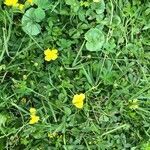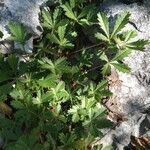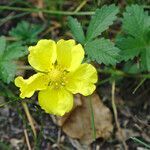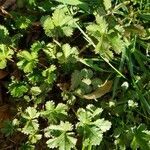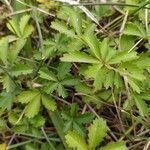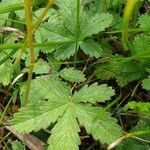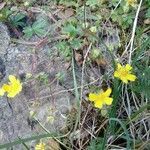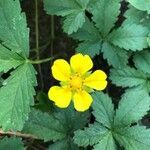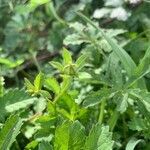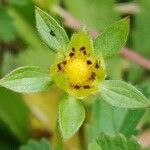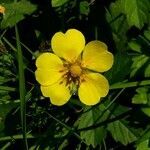Herbs perennial, stoloniferous. Roots much branched, usually with fusiform, tubers. Stolons 20–100 cm, sparsely pilose or glabrescent, with adventitious roots at nodes. Radical leaves 7–12 cm including petiole; stipules brown, membranous, abaxially glabrescent; petiole sparsely pilose, appressed sericeous, or glabrescent; leaf blade pedately 5-foliolate, or 3-foliolate; leaflets shortly petiolulate or subsessile, obovate to obovate-oblong, abaxially pilose or appressed sericeous, rarely glabrescent, adaxially subglabrous, base cuneate, margin acutely or obtusely serrate or lobed to parted, sometimes entire, apex obtuse; stolon leaves resembling radical ones; stipules green, ovate-oblong or ovate-lanceolate, herbaceous, margin entire, rarely 1-or 2-serrate, apex acute or acuminate. Flowers solitary, axillary or opposite leaves, 1.5–2.2 cm in diam.; pedicel 6–9 mm, pilose. Sepals ovate-lanceolate, apex acute; epicalyx segments oblong-elliptic or elliptic-lanceolate, nearly equaling sepals, markedly enlarged in fruit, abaxially pilose, apex obtuse or acute. Petals yellow, broadly obovate, slightly longer than sepals, apex markedly emarginate. Style subterminal, thin at base; stigma dilated. Achenes yellow-brown, ovoid, markedly rugose. Fl. and fr. Apr–Sep.
Procumbent perennial herb arising from a slender, stoloniferous stock; stolons up to 50-(100) cm long; stems greenish brown, sparsely to moderately hairy, rooting at nodes. Lvs in persistent open rosettes, and cauline; petiole 20-60-(160) mm long, hairy; blade ± triangular to reniform, palmate; leaflets (3)-5, oblanceolate to obovate, ± sessile, (7)-15-35-(60) × 4-16 mm, sparsely to moderately clothed in long hairs especially below, dentate to serrate especially on upper part of leaflets; teeth in 3-11 pairs on terminal leaflet; upper cauline lvs smaller; stipules linear-lanceolate, acute, entire or with 1-2 teeth. Fls solitary in axils of lvs, 5-merous. Epicalyx segments narrow-elliptic to lanceolate, (4)-7-12 mm long, acute, entire. Sepals narrow-elliptic-ovate, slightly < epicalyx segments, glabrate to sparsely pilose, sometimes purplish, connate at base. Petals broadly obovate, 6-10-(12) mm long, pale yellow, undulate to shallowly emarginate. Styles filiform. Achenes not seen.
Stems prostrate and creeping, to 1 m; principal lvs long-petioled; lfls 5 or 7, obovate or oblong-obovate, the median 2–5 cm, the lateral progressively shorter, all crenate; fls solitary (2) from the axils, long-pedicellate, yellow, 18–25 mm wide; bractlets often exceeding the sep; anthers 1.3–2.0 mm; 2n=28. Native of Eurasia, intr. in lawns, roadsides, and waste places; N.S. to O. and Va. June–Aug.
A creeping herb. It keeps growing from year to year. The roots are much branched. They have tuberous roots. There are stolons or runners 20-100 cm long. These root at the nodes. The leaves near the roots have 5 divisions at the end of the leaves.
